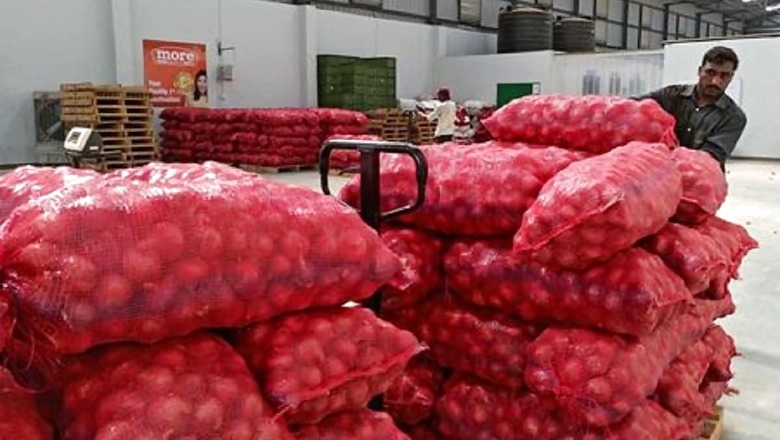
views
The retail price of onions has tripled in October in Puducherry, from Rs 30 a kg on the first day of the month to Rs 90 on Thursday. According to retail price data from the Ministry of Consumer Affairs, in Kerala’s Palakkad, onions were selling at Rs 100 a kg, up from Rs 45 on October 1. Poll bound Patna and Ludhiana in Punjab have both seen a Rs 20 spike in onion prices in these 22 days. Onion prices are on fire largely due to supply side shock, as heavy unseasonal rains in producing states have severely impacted supplies.
Jayachandra Muthyala, a wholesaler and exporter of onions in Nashik, was selling onions in the wholesale market at anywhere between Rs 41-43 a kg till a fortnight back. Now, the price has nearly doubled to Rs 80. He said that Bijapur (Karnataka) and Kurnool (AP) are two big onion producing regions and both have witnessed heavy rainfall, impacting crops. “This has put undue pressure on the only other large onion bowl, Nashik. The Centre has already banned onion exports to control prices but Nashik is now also witnessing rains for the last one week. Unless new crop arrives in the market, prices will remain elevated.”
Such a spike in onion prices shows that overall food inflation is likely to remain high due to further supply shocks. Retail prices of potato have also begun firming up besides wholesale prices of some other commodities like tea, which have also risen substantially. In the case of tea, though, large FMCG companies have not passed on the nearly 80% price increase to consumers, so retail prices have not been impacted significantly.
It is interesting to note that retail price inflation has raised its ugly head in these months despite weak consumption demand due to the Covid-19 fallout and within overall inflation, the spike in prices of fruits and vegetables is the biggest culprit. Also, spurt in veggie prices not only hurts the homemaker’s budget in these trying times of a global pandemic and widespread loss of livelihoods, it also derails further easing of monetary policy.
Analysts at ratings agency ICRA have noted that retail prices of cereals have stabilied but those of pulses and oilseeds are rising. So not just onion, potato and tea, official data show that tur (arhar) daal has also galloped. In Prime Minister Narendra Modi’s constituency, Varanasi, for example, prices have increased by Rs 34 a kg since the beginning of October to Rs 130 on October 22. In fact, this North Indian staple dal is now retailing at a modal price (rate at which most trade for onions took place) of Rs 100 a kg across the country.
The ICRA analysts have said that though such high food inflation will eventually prove “transient”, “the average inflation figures for FY2021 as well as H2 FY2021 (October 2020-March 2021) are likely to be uncomfortably high. Amidst the unpalatable headline and food inflation figures, the relatively stable core inflation over the last three months offers some relief, keeping the hopes of a February 2021 rate cut alive.”
For September, the Consumer Price Index (CPI) based inflation was at an eight-month high at 7.3%. It was at nearly double the print compared to the same month last year, when it was reported at just 4%. When compared to August too, consumer prices are up since the CPI was 6.7% then. At 7.3% for September, this would be the sixth back to back month when CPI inflation has remained above the RBI’s inflation target of 4% (+/- 2%).
Anagha Deodhar of ICICI Securities noted that such persistently high inflation even during the times of weak aggregate demand has led to concerns that supply shock is outweighing demand shock in the economy. Put simply, this means that prices are rising not because of higher demand but due to inadequate supply.
She also said that the share of states with the highest incidence of Covid19 cases in national CPI fell to 37% from 46% in Q2FY20. “This shows that states with higher spread of Covid-19 are recording much lower inflation compared to the rest of the country, possibly indicating that demand shock in these states is outweighing supply shock.” So, people in states where Covid-19 cases are high are not buying enough. The reverse is true for those states where Covid-19 cases are the lowest – in these states, high prices are due to supply constraints.
Meanwhile, the RBI has said in its last monetary policy statement in the beginning of October that CPI inflation is projected at 6.8% in Q2 but is expected to moderate in next two quarters: large favourable base effects are expected to pull it down to 5.4% in Q3 and 4.5% in Q4. The Central Bank has also said that for 2021-22, inflation will move in a much lower range of 4.1-4.4%. Only, such a benign forecast is peppered with conditions: The RBI has assumed normalisation of supply chains with the availability of effective vaccines against Covid-19, a normal monsoon and no major exogenous or policy shocks.
Read all the Latest News and Breaking News here




















Comments
0 comment